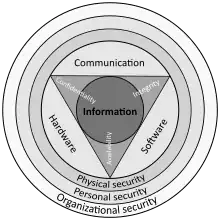The EICAR Anti-Virus Test File[1] or EICAR test file is a computer file that was developed by the European Institute for Computer Antivirus Research (EICAR) and Computer Antivirus Research Organization (CARO) to test the response of computer antivirus (AV) programs.[2] Instead of using real malware, which could cause real damage, this test file allows people to test anti-virus software without having to use a real computer virus.[3]
Anti-virus programmers set the EICAR string as a verified virus, similar to other identified signatures. A compliant virus scanner, when detecting the file, will respond in more or less the same manner as if it found a harmful virus. Not all virus scanners are compliant, and may not detect the file even when they are correctly configured. Neither the way in which the file is detected nor the wording with which it is flagged are standardized, and may differ from the way in which real malware is flagged, but should prevent it from executing as long as it meets the strict specification set by European Institute for Computer Antivirus Research.[4]
The use of the EICAR test string can be more versatile than straightforward detection: a file containing the EICAR test string can be compressed or archived, and then the antivirus software can be run to see whether it can detect the test string in the compressed file. Many of the AMTSO Feature Settings Checks[5] are based on the EICAR test string.[5]
Design
The file is a text file of between 68 and 128 bytes[6] that is a legitimate .com executable file (plain x86 machine code) that can be run by MS-DOS, some work-alikes, and its successors OS/2 and Windows (except for 64-bit due to 16-bit limitations). The EICAR test file will print "EICAR-STANDARD-ANTIVIRUS-TEST-FILE!" when executed and then will stop. The test string was written by noted anti-virus researchers Padgett Peterson and Paul Ducklin and engineered to consist of ASCII human-readable characters, easily created using a standard computer keyboard.[7] It makes use of self-modifying code to work around technical issues that this constraint imposes on the execution of the test string.[8]
The EICAR test string[9] reads[10]
X5O!P%@AP[4\PZX54(P^)7CC)7}$EICAR-STANDARD-ANTIVIRUS-TEST-FILE!$H+H*
The third character is the capital letter 'O', not the digit zero.
The string's hash values (68 bytes without any trailing newline character) are as follows:
| Hash type | Value |
|---|---|
| CRC32 | 6851cf3c |
| MD5 | 44d88612fea8a8f36de82e1278abb02f |
| SHA1 | 3395856ce81f2b7382dee72602f798b642f14140 |
| SHA224 | b42ec8b47deb2dc75edebd01132d63f8e8d4cd08e5d26d8bd366bdc5 |
| SHA256 | 275a021bbfb6489e54d471899f7db9d1663fc695ec2fe2a2c4538aabf651fd0f |
| SHA384 | 038f2e50e33dacef50d7e503b45c3525fcdbe89a823f9c44 |
| SHA512 | cc805d5fab1fd71a4ab352a9c533e65fb2d5b885518f4e565e68847223b8e6b8 |
Adoption
The developers of one anti-virus software, Malwarebytes, have said that they did not add the EICAR test file to their database, because "adding fake malware and test files like EICAR to the database takes time away from malware research, and proves nothing in the long run".[11][12]
According to EICAR's specification the antivirus detects the test file only if it starts with the 68-byte test string and is not more than 128 bytes long. As a result antiviruses are not expected to raise an alarm on some other document containing the test string.[13] The test file can still be used for some malicious purposes, exploiting the reaction from the antivirus software:
- A race condition involving symlinks can cause antiviruses to delete themselves.[14]
- A QR-encoded EICAR test file crashes some CCTV systems.[15]
See also
- GTUBE – a similar test for unsolicited bulk email (email spam)
References
- ↑ "Is Your Antivirus Working?". PCMAG. Retrieved 17 April 2017.
- ↑ Hay, Richard (12 September 2016). "How To: Test the SmartScreen Filter and Windows Defender Detection Scenarios". IT Pro Today. Retrieved 3 July 2019.
- ↑ Hess, Ken. "360 Total Security Anti-virus first impressions: Refreshingly subtle but thorough | ZDNet". ZDNet. Retrieved 17 April 2017.
- ↑ "The Use and Misuse of Test Files in Anti-Malware Testing" (PDF). AMTSO. 24 February 2012. Retrieved 3 July 2019.
- 1 2 "AMTSO Security Features Check Tools". AMTSO.
- ↑ Willems, Eddy (June 2003). "The Winds of Change: Updates to the EICAR Test File" (PDF). Virus Bulletin.
- ↑ Willems, Eddy. "EICAR's Test File History" (PDF). Eicar – European Expert Group for IT–Security. Archived from the original (PDF) on 16 December 2015. Retrieved 9 May 2020.
- ↑ "Anatomy of the EICAR Antivirus Test File". NinTechNet's updates and security announcements.
- ↑ "EICAR-STANDARD-ANTIVIRUS-TEST-FILE". Retrieved 21 July 2019.
- ↑ "Virus Profile: EICAR test file". McAfee. Archived from the original on 5 February 2009. Retrieved 9 May 2020.
- ↑ "Malwarebytes can't detect EICAR Test Virus". Malwarebytes Forums.
- ↑ "Malwarebytes 3 – Frequently Asked Questions". Malwarebytes Forums.
- ↑ "Download Anti Malware Testfile – Eicar" (in German).
- ↑ "Exploiting (Almost) Every Antivirus Software – RACK911 Labs".
- ↑ "EICAR test QR".
External links
- Official website (also known as the European Expert Group for IT-Security)
- An Examination of the EICAR's Standard A-V Test Program Assembly-language analysis of the EICAR test file
- VirusTotal Antivirus results from scanning the EICAR file
- "The Use and Misuse of Test Files in Anti-Malware Testing". Anti-Malware Testing Standards Organization. Archived from the original on 16 August 2017.
